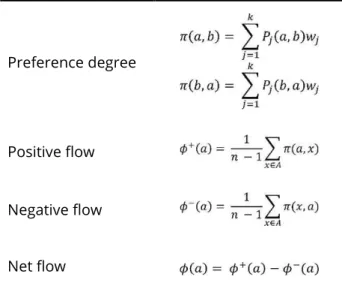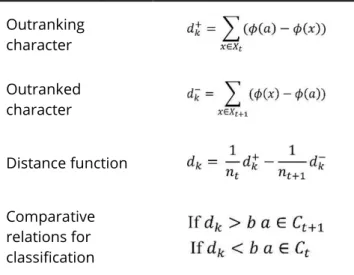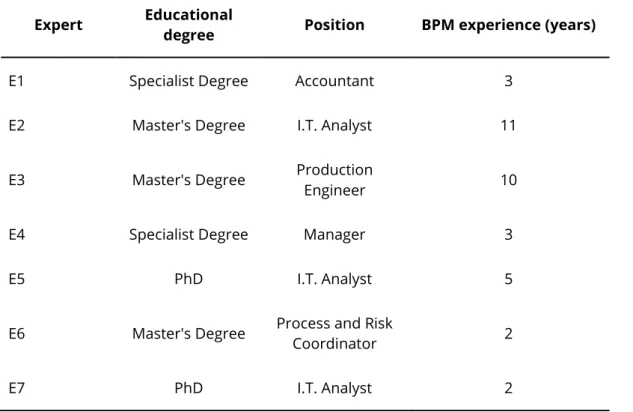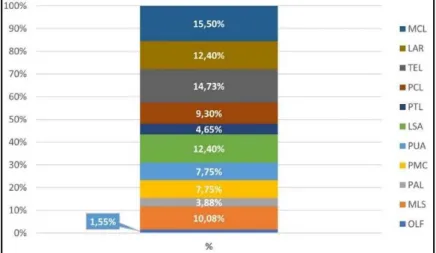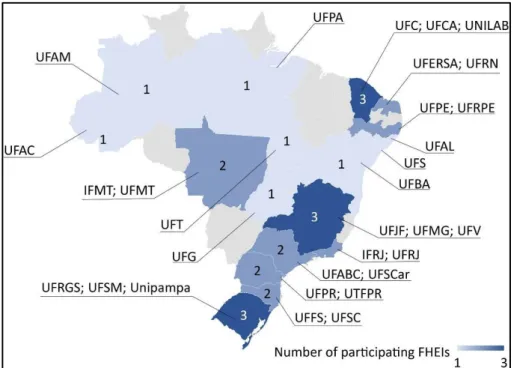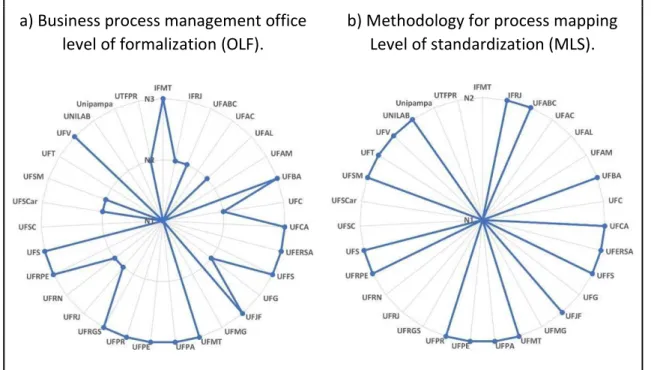Costa & Moreira (2018) mapped and analyzed the processes of the Human Resources Administration Department of the FHEI in the Brazilian Northeast. 2017) present the experience of the implementation of the process office at FŠU, noting that process management is an instrument for achieving process management in the organization. Since the aforementioned research is about the analysis of FSU in a given time frame, the authors concluded that it is necessary to evaluate the development of process management maturity in this type of institution.
The methodology is organized in three phases: (i) construction of the assessment model, (ii) data collection, and (iii) classification of the HEIs regarding their level of maturity in process management. In step 1, the criteria used in the evaluation model of the maturity level in process management of HEIs were established. In this phase, the experts were invited to discuss and express their opinions on the relative importance of the criteria obtained in the previous phase.
In the third step, the classification of higher education institutions was carried out using the PROMSORT method (PROMETHEE sorting), an extension of the PROMETHEE family (Preference Ranking Organization Method for Enrichment Evaluation). The ranking of the alternatives is determined based on the balance of the net flow in the criteria, the difference between the positive flow (overcoming the strength of one alternative in relation to another) and the negative flow (weakness of an alternative to be overcome in relation to another) (Araz &.
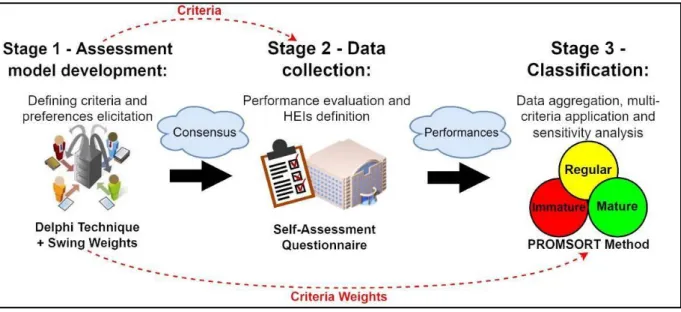
4 RESULTS
Building the evaluation model: defining criteria and preferences’ elicitation
The definition of the criteria adopted in the classification process was carried out using the Delphi technique with seven experts making up the model construction phase. In the first round of Delphi interaction, nine criteria were previously proposed: (i) the level of formalization of the business process management office (OLF), (ii) the level of standardization of the process mapping methodology (MLS), (iii) the level of process automation (PAL). ), (iv) Performance Measurement Capability (PMC), (v) Process Update (PUA), (vi) Management Tools Technology Level (MTL), (vii) Strategic Alignment Level - IDP and Value Chain (LSA), (viii ) Process Transparency Level – Repository Adoption (PTL) and (ix) Process Culture Level (PCL). Of the proposed criteria, eight were approved: MLS, PMC, PUA, LSA, and PTL with 100% agreement, and OLF, PAL, and PCL with 71.4% agreement.
The FTA criterion was rejected for receiving only 28.6%, below the minimum required to be listed. At the end of this round, the experts suggested four new criteria: (x) Level of Process Transformation Efficiency (TEL), (xi) Level of alignment with the institution's risk management (LAR), (xii) Coverage Capacity of the Institution (ICC). ) and (xiii) High Justice Commitment Level (MCL). In the second round of Delphi interaction, the CCI criterion was rejected, having received 57.1% consensus, and the others were adopted with 85.7% consensus.
During the process of establishing preferences, it was found that the experts easily reached a common consensus on the OLF, TEL and MCL criteria. For the other criteria (MLS, PAL, PMC, PUA, LSA, PTL, PCL and LAR), the need for further debate was noted, where they began to try to influence each other's judgments, to present personal experiences and opinions. According to the experts, MCL was rated as the most important because top management support is considered fundamental to the success of any process management initiative, meaning that this criterion was also perceived as determining good performance in other criteria.
For positions 3 to 10, the criteria are paired because of their interdependence, which led to discussion among the experts during the meeting. Third place was taken by the LSA criterion, given its importance for prioritizing process improvements in the eyes of the specialists. In fifth and sixth position are the MLS and the PCL, respectively, where the MLS was more relevant because standardization is believed to be necessary to support a good process culture.
Finally, PTL was ranked ninth, followed by PAL, where transparency stood out in the order of importance due to its importance for the integration of processes in the institution, an important characteristic in the context of process automation.
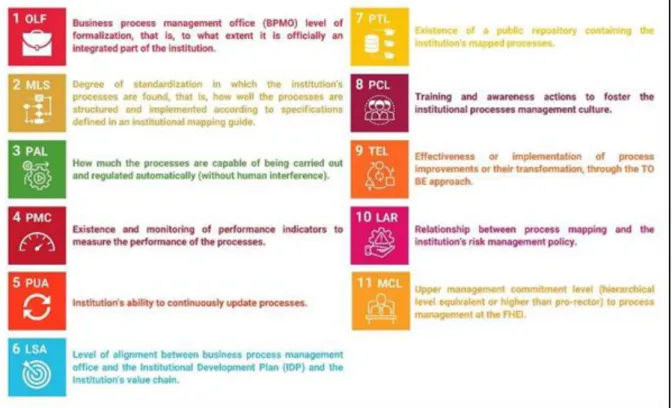
Self-assessment of the FHEIs’ performances
On the other hand, the OLF criterion was given the least importance, under the argument that process-oriented initiatives that have the support and involvement of managers are more effective for success in process management than a formalized initiative that does not have such support. TEL, however, was ranked second by experts for its effectiveness in creating improvements, adding value to processes, and contributing to winning or retaining the support of top management. Next, in fourth place, LAR was ranked due to its great proximity to the previous criterion.
The PMC and PUA criteria were assigned to the seventh and eighth position, respectively, to consider that process updates should be based on performance indicators. Legend: OLF - Office Business Process Management Formalization Level; MLS - Process Mapping Methodology Level of Standardization; PAL - Process Automation Level; PMC - Performance. To collect data, exploratory research was done on the official websites of the FHEIs to collect as much contact information as possible from the sectors.
This research was done in an attempt to maximize the alternatives included in the model. Furthermore, the information resulting from this research was added to a contact list provided by the Universidade Federal Rural do Semi-Árido (UFERSA) process office and formed a contact base referring to 44 IHEs. With this, all institutions in this contact base have been contacted by email so that they can respond to the self-assessment performance questionnaire.
Through the self-assessment questionnaire, performance data were collected for each of the 11 criteria identified in the first phase of the survey from 31 HEIs.
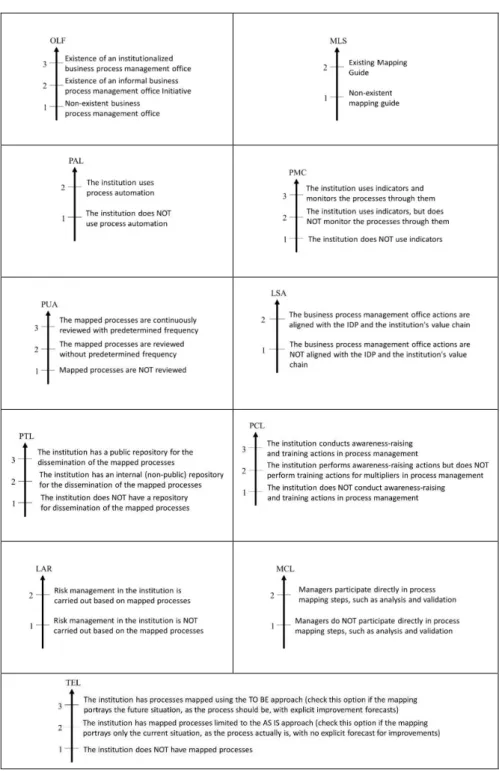
Classification of the FHEIs as to maturity level in process management
Observing Figure 8 from an optimistic point of view, it can be seen that the Midwest and South regions do not host FHEIs classified as immature, while the North and Northeast regions each host one immature institution, and the Southeast region the largest number of immature FHEIs, with two such classifications. With regard to institutions classified as regular, it is verified that the North and Midwest regions are linked with two classifications, followed by the Southeast region with three, the South region with four and, finally, the Northeast region with five regular FHEIs. In addition, the Northeast region also had the most institutions classified as mature under the optimistic perspective, closely followed by the South region, which had three mature classifications.
The Southeast region presented two FHEIs classified as mature and was ahead of the North and Midwest regions, which presented only one mature classification each. In the pessimistic perspective, only the North-East and South regions presented variations in their classifications compared to the optimistic view. From a pessimistic point of view, the Northeast region thus loses its position as a leader in the number of mature FHEIs to the South region.
Furthermore, the Midwest region becomes the only one not to present an institution classified as immature. In order to assess the robustness of the results in relation to their behavior and stability, a sensitivity analysis has been carried out which, in addition to the 11 established criteria, took into account the variation of weights and views. Therefore, the remaining alternatives did not present variations and were classified in all scenarios, regardless of the variation in views or criteria weights, as mature (UFERSA, UFJF, UFMT, UFPA, UFPR, UFRPE, UFSM, UFV and Unipampa). regular (IFMT, UFABC, UFAM, UFBA, UFFS, UFRGS, UFRN, UFS, UFSCar, UFT, UNILAB and UTFPR) or immature (UFAC, UFAL UFMG and UFRJ).
In the optimistic perspective, the FHEIs IFRJ and UFPE were classified as mature in 21.74% and 17.39% of the scenarios. On the other hand, the pessimistic viewpoint indicates a minor variation in ranking only for UFSC, which presented itself as regular in only 2 (8.7% of the pessimistic simulations) pessimistic scenarios. It is therefore observed that regardless of whether they adopt an optimistic or pessimistic perspective, most FHEIs (51.6% in the optimistic perspective and 54.8% in the pessimistic one) were classified as regular, and that 25 of the 31 (80.6% of the FHEIs) ) retained their classifications regardless of the scenarios studied.
These alternatives, despite not being sensitive to variations in the criterion weights, showed greater sensitivity with respect to the point.
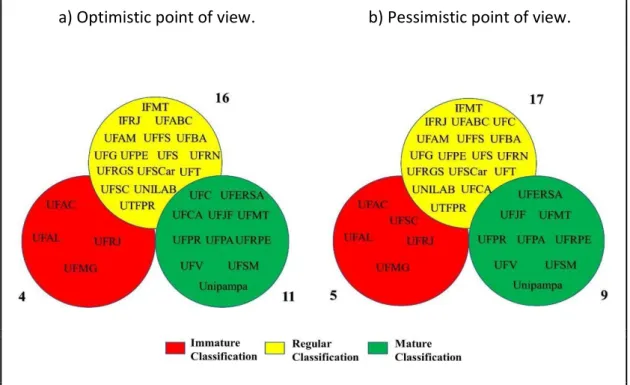
5 CONCLUSIONS
Such a platform will work as a virtual environment in line with Taskymbayeva, Shaikh & Salimbayeva (2022) thinking, promoting the search for best practices in process management in HEIs through the exchange of information and performance data of institutions, and a reference for decision-making becomes for HEI managers and leaders who define related public policies.
Guia de Gestão de Processos Governamentais - Áreas de Integração para Arquitetura de Governo Eletrônico e Interoperabilidade ping. Gestão de processos de negócios em instituições de ensino superior alemãs: o caso da Jade University of Applied Science. Análise do impacto nos custos de transporte de um modelo de seleção de fornecedores baseado em variáveis socioambientais e de competitividade.
Sistemas de classificação de produtos com base na avaliação incerta da sustentabilidade do ciclo de vida: uma abordagem estocástica de análise multicritério. Gestão e mapeamento de processos em instituições públicas: um estudo de caso em uma universidade federal. Gestão de processos e avaliação de desempenho no setor público brasileiro: um estudo de caso em uma instituição pública de ensino superior.
A trajetória do surgimento do campo processual: o estudo da implantação do cartório processual em uma instituição federal de ensino superior. Gestão de processos aplicada ao estabelecimento de acordos bilaterais internacionais em uma instituição pública brasileira de ensino superior. Análise dos fatores críticos de sucesso em Business Process Management em organizações públicas.
Bachelor's degree in Industrial Engineering from Universidade Federal Rural do Semi-Árido Orcid: https://orcid.org X. Master's in Environment, Technology and Society from Universidade Federal Rural do Semi-Árido Orcid: https://orcid.org.
